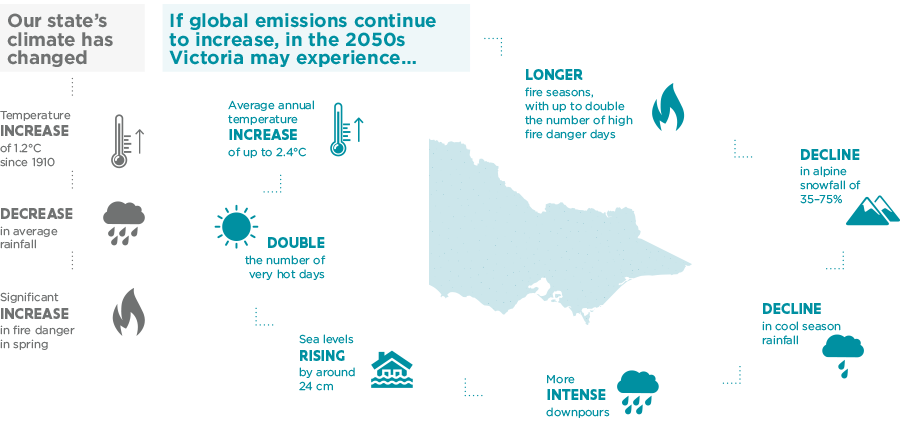Our climate is changing
The most recent findings of the Intergovernmental Panel on Climate Change demonstrate that the changes in the world’s climate are widespread, rapid and intensifying. Human influence is contributing to many observed changes in extreme events, such as heatwaves and droughts. Some changes, such as sea-level rise, are already irreversible. Even if the world succeeds in limiting global warming to 1.5 degrees Celsius, some climate impacts will be with us for many decades to come.
Now is a critical moment for Victoria to respond to the risks and opportunities of climate change and to build resilience to the climate impacts we cannot avoid.
Our framework for climate action is world-leading
Victoria’s Climate Change Act 2017 cements in law a commitment to achieve net-zero emissions by 2050 and establishes a 5-yearly framework for reducing emissions and adapting statewide systems to address the unavoidable impacts of climate change.
Victoria's Climate Change Strategy is a 5-year plan that:
- outlines ambitious yet achievable emission reduction targets for 2025 and 2030 and the actions to achieve them
- identifies Victoria’s adaptation priorities for the next 5 years – addressing current climate change impacts, reducing barriers to adaptation, and laying the foundations for transformational adaptation so we are prepared for future climate scenarios.
We’re taking critical steps to adapt now
To achieve our adaptation priorities over the next 5 years and beyond, Victoria has a comprehensive, evidence-based approach centred around adaptation planning for statewide systems and complementary community-led action.
Building Victoria’s Climate Resilience sets out how the Government is driving ambitious adaptation action by:
- using the latest climate science
- building on Victoria's track record of investment in adaptation
- taking steps to ensure the social and economic opportunities of a climate-resilient Victoria benefit all people and communities across our state, now and into the future
- implementing Adaptation Action Plans for 7 statewide systems that are vulnerable to climate change or vital to building our state's climate resilience.
As our climate changes, we need to adapt

Under high emissions, compared to the period 1986–2005. Updated from Victoria’s Climate Science Report 2019.
We are using the latest climate science to guide our adaptation action
Victoria’s climate has warmed by 1.2°C since records began in 1910. Our warmer and drier climate means more hot days and harsher fire seasons. There will be less overall rainfall and snow, but more intense rainfall events, increasing the risk of flash flooding in some locations.
With global warming set to continue until at least mid-century under all emissions scenarios, Victoria needs a robust foundation of science and research to guide our future climate action.
The Victorian Government is investing in a climate science program and leveraging national research. Victoria’s Climate Science Report 2019 describes how our climate is changing and includes local-scale future climate projections for Victoria, developed with the Commonwealth Scientific and Industrial Research Organisation (CSIRO). The next report is due in 2024.
The projections, supporting tools and guidance are informing decisions about adapting public health, urban planning, primary production, water, transport and energy infrastructure, and the protection of our ecosystems.
Interactive climate model simulations are available online via Victoria’s Future Climate tool.
We are building on a strong track record
Adapting through our support programs, policies and services
- $384 million committed for forest and fire management to protect our communities and environment and reduce bushfire risk in a changing climate
- Over $37 million for community-centred forest management and supporting Traditional Owners to manage Country
- Major water management reforms across Victoria to respond to the historic Millennium Drought (1996–2010)
- $10 million for Clean Economy Workforce Skills that will support training for future jobs in building Victoria’s climate resilience
- A comprehensive marine and coastal policy to support a healthy, dynamic and biodiverse marine and coastal environment
- Delivering innovative disaster resilience education for students in schools vulnerable to fire, floods or storms
Building the resilience of our assets and operations
- $797 million for Victoria’s household energy savings package to help Victorians reduce their power bills and make homes more energy efficient
- Over $11 million to protect Victoria’s coastline through projects tackling rising sea levels and coastal erosion
- An additional $10.4 million to complete the Macalister irrigation district modernisation to save water, reduce runoff and improve water quality
- $133.5 million for better communications during emergencies through upgraded digital radios for forest and fire management staff and volunteers
- Expansion of the Powerline Bushfire Safety Program to make powerlines safer – with 736km of overhead powerlines already replaced in high-risk bushfire areas
Page last updated: 26/03/25